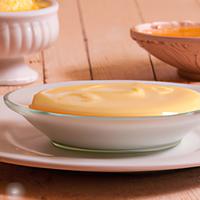
1 serving (150 grams) contains 200 calories, 6.0 grams of protein, 8.0 grams of fat, and 25.0 grams of carbohydrates.

Log this food in SnapCalorie

Nutrition Information
Calories |
315.5 | ||
|---|---|---|---|
% Daily Value* |
|||
| Total Fat | 12.6 g | 16% | |
| Saturated Fat | 6.3 g | 31% | |
| Polyunsaturated Fat | 0 g | ||
| Cholesterol | 126.2 mg | 42% | |
| Sodium | 157.7 mg | 6% | |
| Total Carbohydrates | 39.4 g | 14% | |
| Dietary Fiber | 0 g | 0% | |
| Sugars | 31.5 g | ||
| protein | 9.5 g | 19% | |
| Vitamin D | 78.9 mcg | 394% | |
| Calcium | 236.6 mg | 18% | |
| Iron | 0.8 mg | 4% | |
| Potassium | 236.6 mg | 5% | |
* Percent Daily Values are based on a 2,000 calorie diet. Your daily values may be higher or lower depending on your calorie needs.
Food Attributes
Source of Calories
About Homemade custard
Homemade custard is a creamy dessert made from simple ingredients: milk or cream, egg yolks, sugar, and often vanilla for flavor. This classic dish is rooted in European cuisine, with variations appearing in recipes dating back centuries. Its rich texture comes from gently cooking the egg yolks, which act as a natural thickener. Custard is a good source of protein and calcium due to its dairy and eggs, supporting bone health and muscle maintenance. However, it can be high in sugar and saturated fat depending on the recipe, making moderation key for those watching their calorie intake. Homemade versions allow greater control over sweetness and fat content, making it a versatile treat for tailoring to dietary preferences. Whether enjoyed on its own or as a topping for pies or fruit, custard is a beloved comfort food with a balance of indulgence and nutritional benefits.



